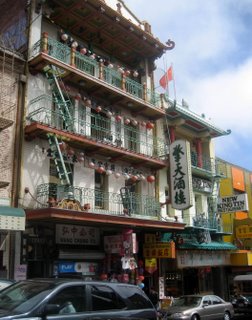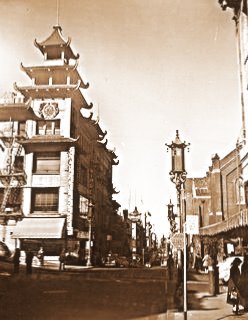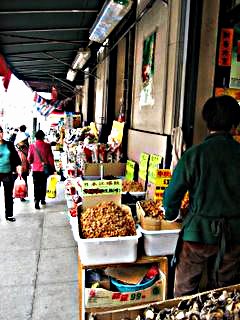San Francisco Chinatown
The Neighborhood
San Francisco Chinatown
What's That - a Neighborhood?
You might be surprised to find that San Francisco Chinatown that is a must-see for every visitor to The City is not just a tourist attraction - it's also a living, breathing, and vibrant example of a San Francisco neighborhood where Chinese immigrants still live, work, play and shop!
Filled with pagoda roofs, temples, herbal shops, Chinese groceries and bakeries, butcher shops, and golden dragon parades, this neighborhood retains its own places of worship, languages, Social clubs, customs, and identity.
Yes, the real Chinatown - the neighborhood - is there for the finding. It's just that you may have to get off the main tourist drag, Grant Avenue to find it. You have
to explore the streets that run parallel to Grant, and the side streets
and alleys that are in between the two and beyond them.
A Little of the Neighborhood's History

Originally the port of entry for Chinese immigrants in the 1850s, the area around Grant Avenue was the only place in San Francisco where they were allowed to live.
So the area naturally evolved into an active and bustling Chinese community.
It has its own exotic shops, pharmacies, hospitals, places of worship, groceries, bakeries, and eateries. Its people live, eat, shop, and work throughout this exotic San Francisco neighborhood.
The majority of the inhabitants were male and had come alone to California in the wake of the Gold Rush to prospect for the precious metal themselves. They called California Gold Mountain.
Many of these men headed for the gold fields to prospect or work in the gold mines, but they also worked as cheap labor
for the railroads, became merchants, laundry owners, fishermen, cannery workers, restaurateurs,
construction workers, and even farmers and farm laborers.
Eventually Chinatown also became home to opium dens, brothels and gambling parlors - many of whose customers were non-Chinese Europeans from outside the area.
The neighborhood suffered much during and after the Panic of 1873. Because of the scarcity of jobs, San Franciscans - like their European counterparts throughout the country - became xenophobic, resulting in race tensions and outright violence against the Chinese immigrants.
When the Great Earthquake struck in 1906, and much of San Francisco was destroyed either by the quake itself, or by the ensuing fires, the Chinese neighborhood was one of the casualties.
Though many wanted to take the opportunity to rid The City of its Chinese populace, those who worked to rebuild the neighborhood as an authentic tourist attraction won the day, using the argument that it would attract tourists and thus add to The City's coffers.
Today the San Francisco neighborhood is an animated
and populated mixture of the old and the new - the cultural heritage of
a people and the pilgrimage of those who would like to know more about
that heritage.
Discover the Real Chinatown,
A San Francisco Neighborhood
The truth of the matter is, there are two Chinatowns in San Francisco, although they're so intertwined as to be nearly inseparable. There's the tourist attraction that caters to tourists from all over the world on Grant Avenue - San Francisco's original and oldest street - with restaurants, bazaars, tea shops, mega-souvenir stores, and bakeries.
Then there's the neighborhood, where the locals live in teeming tenements, where there are murals and back alleys, gilt buildings, lucky addresses, monkey-paw prints, and tales of brothels, opium dens, gambling parlors, and sweatshops from the old days.
Though in no way hidden, Portsmouth Square is part and parcel of the real neighborhood. Most of the approximately 27,000 people who live here are crowded into small tenement apartments (that are about 8' by 9' and are shared with 4 or 5 other people), so Chinatown's largest open-spaced area, Portsmouth Square, is the center of community life.
Children play at the jungle gym, grandmothers visit and gossip, people practice Tai Chi or take their daily constitutionals, old men while away the afternoon playing Elephant Chess and Wei Qi.
A good time to visit to see the neighborhood is in the early morning when Chinese families are hustling about, doing their daily grocery shopping (as many do not have refrigerators) before heading off to jobs or appointments.
Meander along Stockton Street and immerse yourself in the sights, sounds and smells of authentic Asian markets offering all manner of fruits, vegetables, and protein (from live animals sold by the pound to already dressed and cooked chickens and ducks hanging by their feet).
And don't forget the in-between streets - Sacramento, Clay, Washington, and Jackson - for other typically Chinese fare including herbalists, tea houses, authentic neighborhood restaurants, and Chinese temples.
One of the most interesting things to do in the area is take a guided tour of the alleyways. The tours are called Chinatown Alleyway Tours, and are run through the Chinatown Community Development Center.
You'll be guided by a young person from the Adopt-An-Alleyway Youth Project - most of whom have lived in the neighborhood and can share, not only the rich historical and cultural aspects of their home with you, but their own personal experience as well!
Both Chinatowns include narrow streets, colorful buildings, green pagoda roofs, Chinese Red banners with white Chinese calligraphy, and the sounds of Cantonese, the main language of Chinatown.
Chinese immigrants continue to come to California, and they frequently start off in the San Francisco Chinatown neighborhood.
Here they find familiar language, foods, and customs to help them get off to a good start, and - while most will eventually leave for a better life elsewhere - there will always be more newcomers to take their places.
Do you have a favorite
NorCal story?
From a family visit from years ago to something
you discovered last weekend,
Share it with
the rest of us - we'd love to learn about it!
If you'd like to know more about other San Francisco neighborhoods, take a look at these:
- Fisherman's Wharf
Fisherman's Wharf is another surprise to most people. It, too, is a neighborhood as well as a tourist attraction! - San Francisco's Marina District
The Marina has a twin! It's called Cow Hollow. - North Beach
Want a virtual tour of San Francisco's North Beach neighborhood? I guarantee you'll find it interesting!
Please continue your exploration of what Northern California has to offer by using the Nav Bars in the left and right columns or by using the links at the bottom of the page.
Like what you're finding here at Discovering Northern California? Then please share with the Social Network of your choice.
And thanks for coming!
Related Pages
SF Neighborhoods
Related Pages
San Francisco
Discover San Francisco
SF Attractions
SF During the Gold Rush
1906 SF Earthquake
SF Neighborhoods
SF Nude Beaches
SF Things To Do
Related Pages
California Gold Rush
California Gold Rush
Discovery of Gold
Getting to California
Gold Rush Trail
Gold Rush Sites
Gold Panning
Related Pages
Northern California Beaches
Related Pages
Bay Area
1906 Earthquake
Alameda County
Contra Costa County
Marin County
San Francisco
San Mateo County
Santa Clara County
Solano County
Related Pages
Hints & Tips
Beach Safety Tips
Best Kept Travel Secrets
Family Camping Tips
iPhone Travel Apps
Nude Beaches
Tide Pool Tips
Travel Sites We Love
Travel Tips
Whale Watching Tips
Wine Tasting Tips
Winter Driving Tips
Related Pages
Things To Do
Activity Village
Attractions
Beaches
Beer Lovers Delight
Burney Falls
Camping
Casa de Fruta
Day Trips
Gold Panning
Gold Rush Sites
Healdsburg
Historic Grass Valley
Lake Shasta Caverns
Lodi
Missions
Nevada City
RV Destinations
Ski Resorts
Tide Pool Tips
Travel Tips
Weekend Trips
Whale Watching
Wine Tasting
Related Pages
Free Things To Do
Free in Big Sur
Free in Chico
Free in San Francisco
Free in Sonoma
Related Pages
Insider Secrets
Best Kept Travel Secrets
Best Winter Whitewater
Boring Road? Nope
CA Admission Day
Climbing at Castle Rock
Crabbing Spots
Dream of Dreams
Fall in Eastern Sierras
Ghost Stories
Glass Beach
Great Stays, Low Pays
How to be a Valley Girl
Jade Beach
Lake Shasta Caverns
Lassen Volcanic SP
Lost Coast
Mono Lake
Moss Landing: Whales
New Clairvaux Abbey
Panning for Gold
Pygmy Forest
Mendo to Eureka
RV Destinations
SF Great Places to Eat
SF: More About Eating
SF Neighborhoods
SF Giants Baseball
Santa Cruz: Memories
Santa Cruz: Old Friends
Sonoma Cooking Class
Sonoma History
Sonoma Top Wine Stop
Tahoe: Discovery Trail
Underground Gardens
Yosemite: Family Hikes
Yosemite: High Country
YNP: Off the Beaten Path
Yosemite: Taft Point
Ziplines

